Maxwell Museum Blog
To commemorate pride month, and to express our support for the LGBTQ+ community, throughout the month, the Maxwell Museum of Anthropology will be posting relevant blog posts written by scholars and curators that tell related stories, as they are to be found embedded in our collections.
Histories, cultures and stories of the LGBTQ+ communities and historic antecedents are often hard to find in museum collections, and museums themselves have often been guilty of ignoring, erasing or obscuring them. The Maxwell Museum of Anthropology is committed to recovering and highlighting these stories, communities and individuals, and the blogs we will post throughout the month are part of fulfilling that commitment, and celebrating the immense contributions of LGBTQ+ people to the human story.
Please celebrate Pride Month with us, and offer us feedback at maxwell@unm.edu.
------------------------------------------------------------------------------------------------------------------------------------------------
See also Post 1: Queer Anthropology & Post 2: Ethnographic Photograph Collections and Other Gendered Stories
------------------------------------------------------------------------------------------------------------------------------------------------
Nampeyo, Maria Martinez, and Arroh-A-Och: Gender and Innovation in Pueblo Pottery
By Lea S. McChesney, Curator of Ethnology, Maxwell Museum of Anthropology
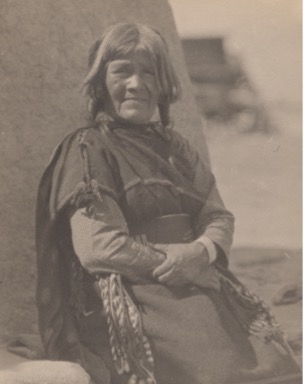
Nampeyo, by Arnold Genthe, c. 1926, National Portrait Gallery, Smithsonian Institution, NPG.98.51. Nampeyo was in her mid-60s at this time.
Though only some of the women discussed in this essay are gender different, all , to varying degrees, challenge the nature of gender as viewed from outside their own cultures in the larger colonial context. We present them here in keeping with the theme of Pride month to honor LGBTQ+ communities and those who defy the expectation of the norm and colonizing notions.
Paragons of Pueblo Pottery
Nampeyo (1859/60–1942) and Maria Martinez (1881/87–1980) have each received honorific titles in the art world, as the first named Native American artist acknowledged by Western art historians and the most famous Pueblo potter, respectively. Yet Namepyo never articulated the intent of her work to outsiders. Her descendants agree that while Nampeyo did not seek fame or artistic recognition in her lifetime, she was and remains widely respected in the First Mesa Hopi (Arizona) community for her pottery skills. Posthumously she was the subject of two biographies.
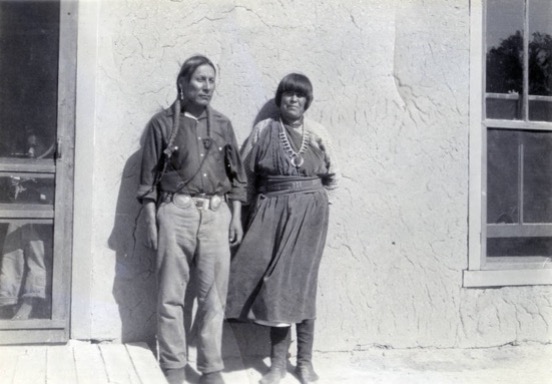
Maria and Julian Martinez, c. 1920s, Center for Southwest Research, University Libraries, University of New Mexico. Maria was likely in her 40s when this photograph was taken.
Succeeding Nampeyo by a generation, Maria received widespread recognition while she lived, including an in-depth biography as well as several posthumous tributes.
Both artists are cited in major art historical texts, recognized as founding “matriarchs” of dynasties of ceramic artists. Each of them is a canonical figure in Native American art: Nampeyo for her stylistic innovations at the inception of a market for Native art and Maria (with her husband Julian) as the 20th century’s most influential Indian artists.
An enigma in the historical record, Arroh-A-Och (c. 1830–c. 1900) may have blazed a trail a generation prior to Nampeyo and two before Maria. A “two-spirit” or “third-gender” person known as “the Laguna Man-Woman,” her reputation as an exceptional potter is based on the stylistic analysis of a single, extraordinary pot (although ten large ollas (jars) have been attributed to her). In the late nineteenth and early twentieth centuries, la’manas (or lhamanas; men-women) were known at Acoma, Tesuque, and Zuni pueblos, where Arroh-A-Och visited. Better known perhaps was We’wha, the famous Zuni la’mana, who in 1886 resided for six months with ethnographers Matilda and James Stevenson in Washington, D.C. Also known as a potter, We’wha and other la’manas collected the clay used in pottery making as well as for plastering buildings, another important way of working with clay in Pueblo communities.
Pottery and Gender in the Pueblo World
Principally produced through women’s labor, pottery was historically and is today made indoors and associated with interior space, gendered as female. Clay is the tangible and conceptual substance of “Mother Earth,” and the emergence of pots intact from the fire—what potters term “baking”—is likened to a birth. As a means of realizing human creativity and procreative potential, separate yet intimately associated with the female human body, clay is a medium for establishing social relationships and engendering new forms of social life: for building and extending the social world.
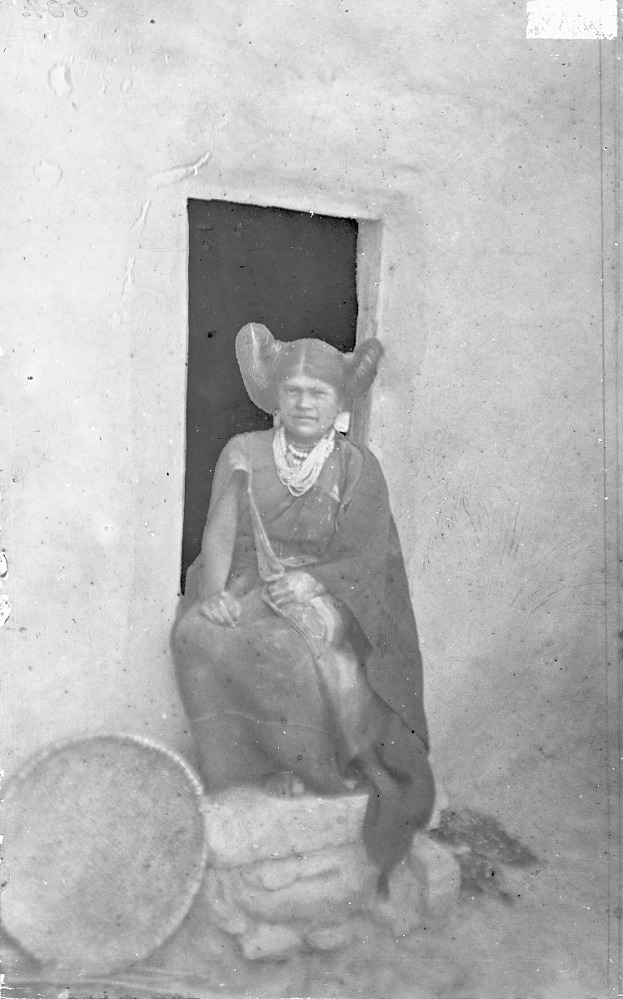
Nampeyo c. 15 years old, with the butterfly whorl hairstyle of an adolescent Hopi girl before marriage. Photograph by William Henry Jackson, National Anthropological Archives, Smithsonian Institution (neg. 1841-C)
Yet while pots objectify close emotional relationships, women’s roles are neither confined to the home nor to nurturing their families. Instead, clan mothers like Nampeyo support extensive social networks and are repositories of knowledge about their group’s identity. Likewise, Maria, as wife of Julian Martinez, governor of San Ildefonso and artistic collaborator, emphasized her village responsibilities. Both women’s leadership roles encompassed teaching pottery making in their families and community networks. Sharing pottery knowledge is akin to sharing other kinds of female knowledge needed for sustenance. Securely grounded in these social roles, they were also acutely responsive to the historical context in which they lived: the imposition of a cash economy and commodities, loss of arable land, and a decline in subsistence activities. When young these women became involved in newly introduced social networks and strategically advanced them as they matured.
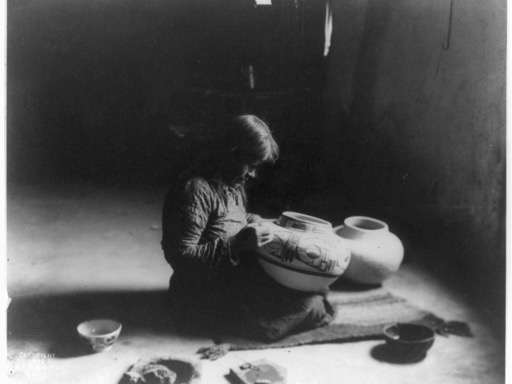
Nampeyo decorating pottery, c. 1900. The design she is painting on the jar is a classic Sikyatiki Revival design, the style she innovated that became dominant in the twentieth century and is still widely used today. Photography by Edward S. Curtis, Library of Congress LOCCN 2003652744
Born a decade after the conclusion of the Mexican-American War (1848), which annexed the Southwest region to the United States, Nampeyo was photographed as a sixteen-year-old in 1875. The image was widely disseminated to the American public, familiarizing her to them and objectifying the network of government and museum contexts she now entered.
As a mature woman and potter, she innovated a new iconographic style that became popular with private and institutional American collectors. However, she never signed her pots.
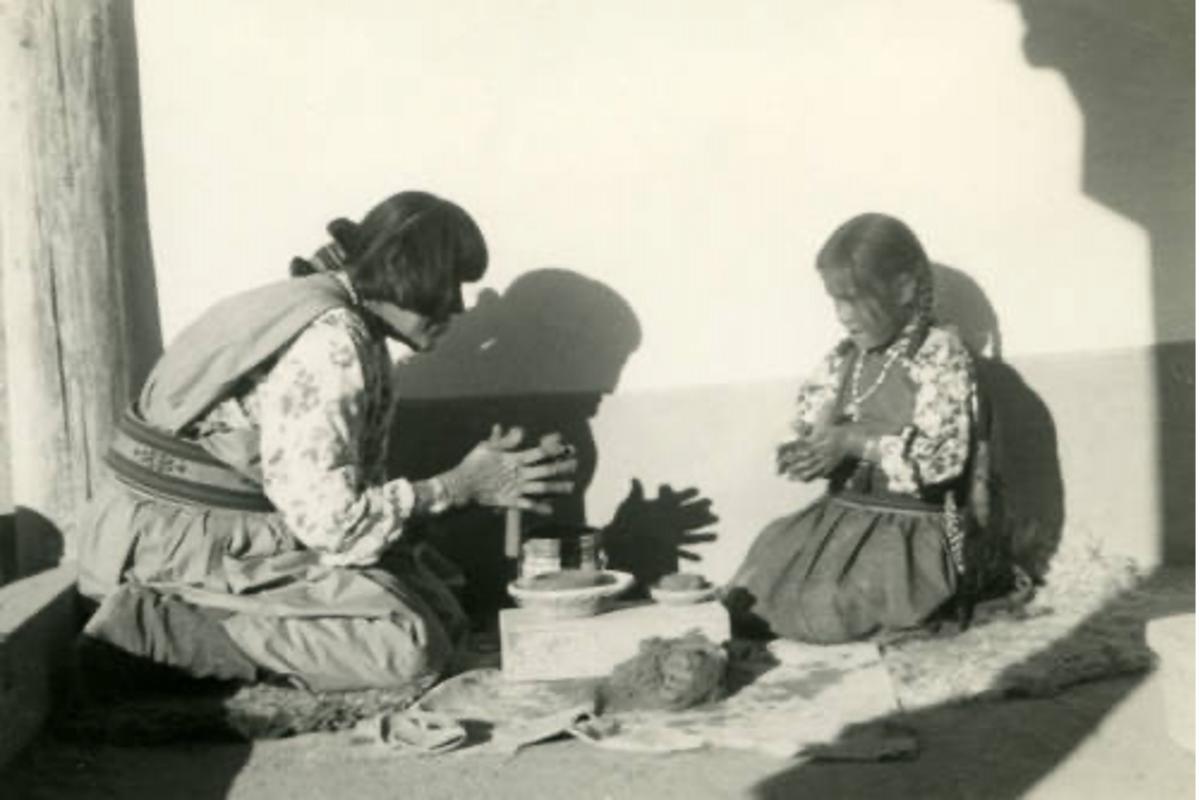
Maria teaching a young girl to make pottery. Center for Southwest Research, University Libraries, University of New Mexico
In Maria’s adolescence at the turn of the twentieth century, 10 percent of deaths in San Ildefonso were due to malnutrition. Yet by the Great Depression in the 1930s, the Pueblo was a center for Indian arts. Maria’s experimentation with black-on-black pottery became well established in the 1920s, demonstrating her initiative in the economic revitalization of the pueblo.
While we lack information about Arroh-A-Och’s life, during her childhood, a significant mid-nineteenth century American economic and missionary presence at Laguna contributed to political changes at the pueblo. This altered social context likely provided changed circumstances not unlike those at Hopi and San Ildefonso, offering new social networks with persons and institutions beyond Laguna.
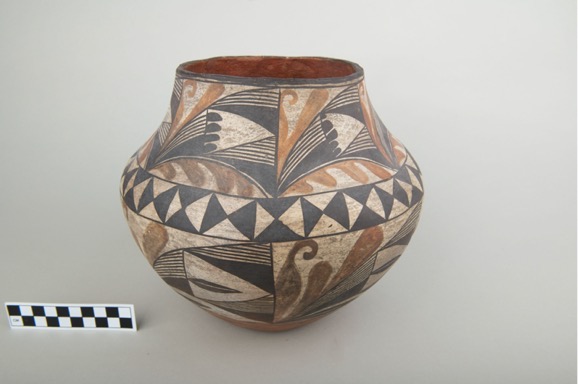
Laguna polychrome pot, c. 1950. Made by an unknown artist, This jar is approximately a century older than when Arroh-A-Och was active. Maxwell Museum 73.33.6
Linking communities and the cosmos through the medium of clay, Pueblo pottery tangibly embodies key concepts of gender, intimacy, and power. The art of pottery represents a form of “soft power,” the means by which women’s pottery making transforms the world according to specific cultural beliefs and aesthetics, such as the musicality or voice of a pot; its beauty of form and design; and the ways that pots transform the spaces they enter. A critical innovation of Nampeyo and Maria (and possibly also Arroh-A-Och) was to extend their social worlds to encompass networks and institutions of the larger society through the wider circulation of their pottery — and of themselves — to new social contexts.
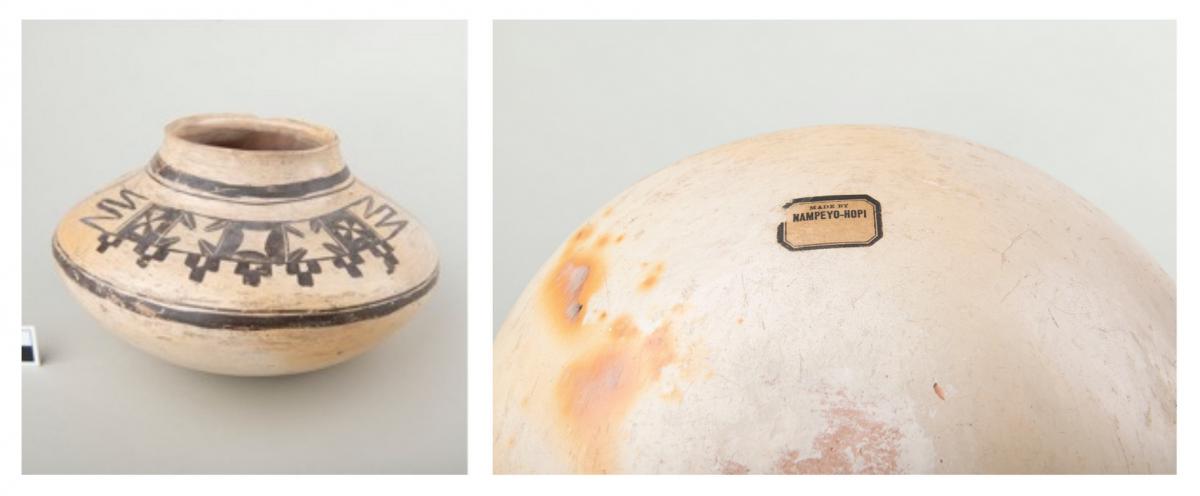
Left: Nampeyo jar c. 1905. This jar is an example of Nampeyo’s early Sikytaki Revival work. Maxwell Museum 72.11.4. Right: Base of Nampeyo jar with Fred Harvey Company label, c. 1905. Nampeyo was a demonstrator for th Fred Harvey Company at Hopi House in the Grand Canyon. Maxwell Museum 72.11.4
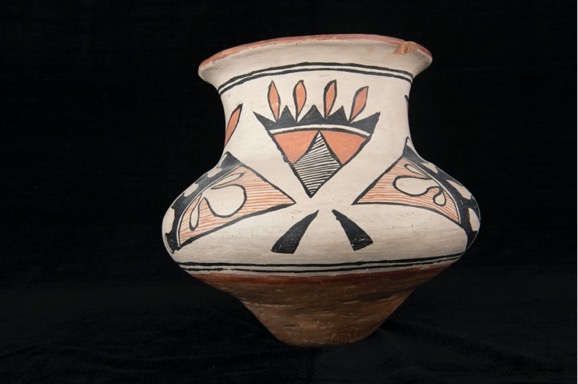
Maria Martinez polychrome jar, c. 1970. While she began by painting polychrome pots, Maria is best known for her blackware pottery. Beginning in the 1950s, she and her son Popovi Da collaborated in pottery production, eventually reviving the polychrome style. Maxwell Museum 78.58.1
Artists and Audiences
The innovation of pots and potters circulating beyond the borders of their communities combined with an emergent Native American art world in the mid-twentieth century. Together these trends solidified the new identity and recognition of individual artists that developed late in Nampeyo’s lifetime but that she did not seek. The new social networks in which these artists initially engaged provided for more expansive distribution of their work, thus developing an audience of collectors and enthusiasts.
In these complex intercultural contexts, the artists had little control over how their work was represented to buyers. Nevertheless, the authoritative publications that accompanied their art established new terms for its appreciation, orienting the buying public toward seeing these objects in the larger society’s terms for valuing art. Although she was known by name, she did not seek this wider recognition her in her lifetime. At home Nampeyo is remembered for technical and aesthetic innovations, as well as for the anchor she provided her family through tumultuous times. The audience of her family and villagers, especially those who now make pottery, remember her influence in moving ways. Nampeyo’s fortitude and passion for her work also contribute to her esteem at home.
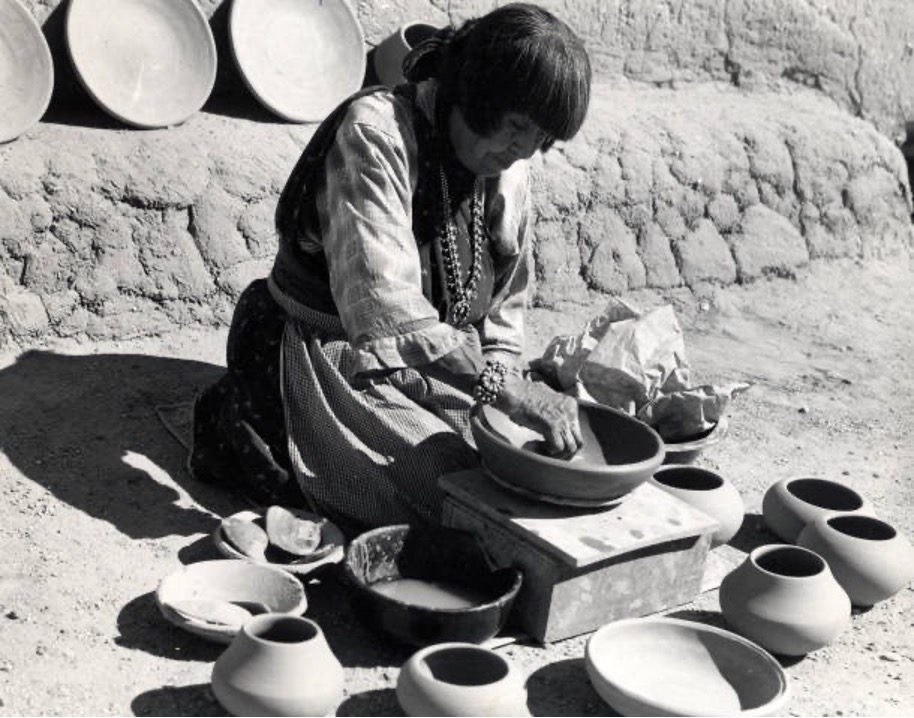
Maria with a large volume of pottery she is no doubt making for sale. Center for Southwest Research, University Libraries, University of New Mexico
In interpreting designs from ruins of the Pajarito Plateau, Maria likewise introduced a pottery style with technical innovations. After she won first prize at the Santa Fe Fiesta and Indian Fair in 1922 (the annual event now known as Indian Market now celebrating its centennial), the style immediately gained both popularity and higher prices. She shared her knowledge with family and community members and taught at the Santa Fe Indian School. And like Nampeyo, she demonstrated pottery production outside the community.
In all of these actions, these artists cultivated local and global audiences for their work. But it was with audiences beyond their communities that their artistic identities were forged. While wide and diverse audiences developed an appreciation of their pottery, in their home communities these artists are remembered for the strength, beauty, and meaning of their work as connected to the values that continued to enhance their way of life—in no small measure through their dedicated efforts.
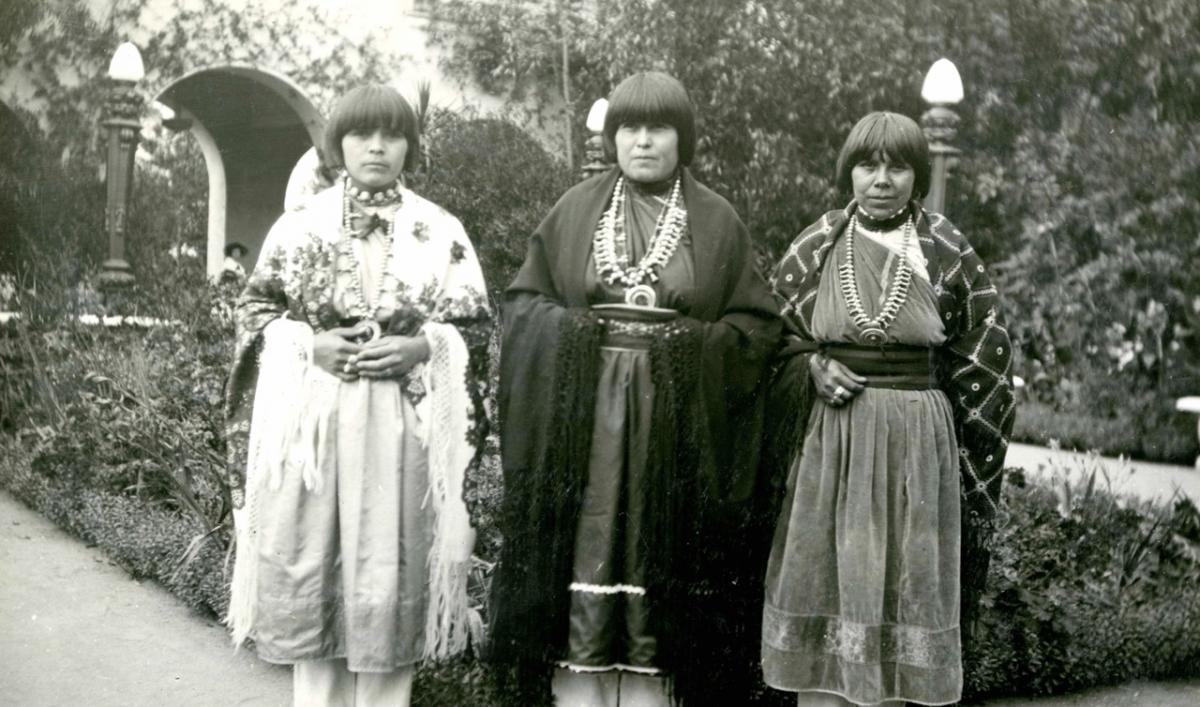
Maria Martinez (center) at the San Diego Exposition (California Pacific International Exposition in San Diego, CA), 1935. Maxwell Museum Archives, 71.18.1394
Making a Living in Pottery
It would be simplistic and historically inaccurate to state that Nampeyo and Maria alone innovated a new means of economic subsistence for themselves, their families, and their communities. Nampeyo’s observations and experiences within the powerful social networks in which she participated alerted her to new possibilities for the changed circumstances of her community—over which, it is important to note, her people had little control. She combined new knowledge with local practices and taught others. Among the Nampeyo family, her specialized knowledge of “making a living” by pottery developed in a way that established a direct market and is now considered a “family business.” The same can be said of Maria’s family.
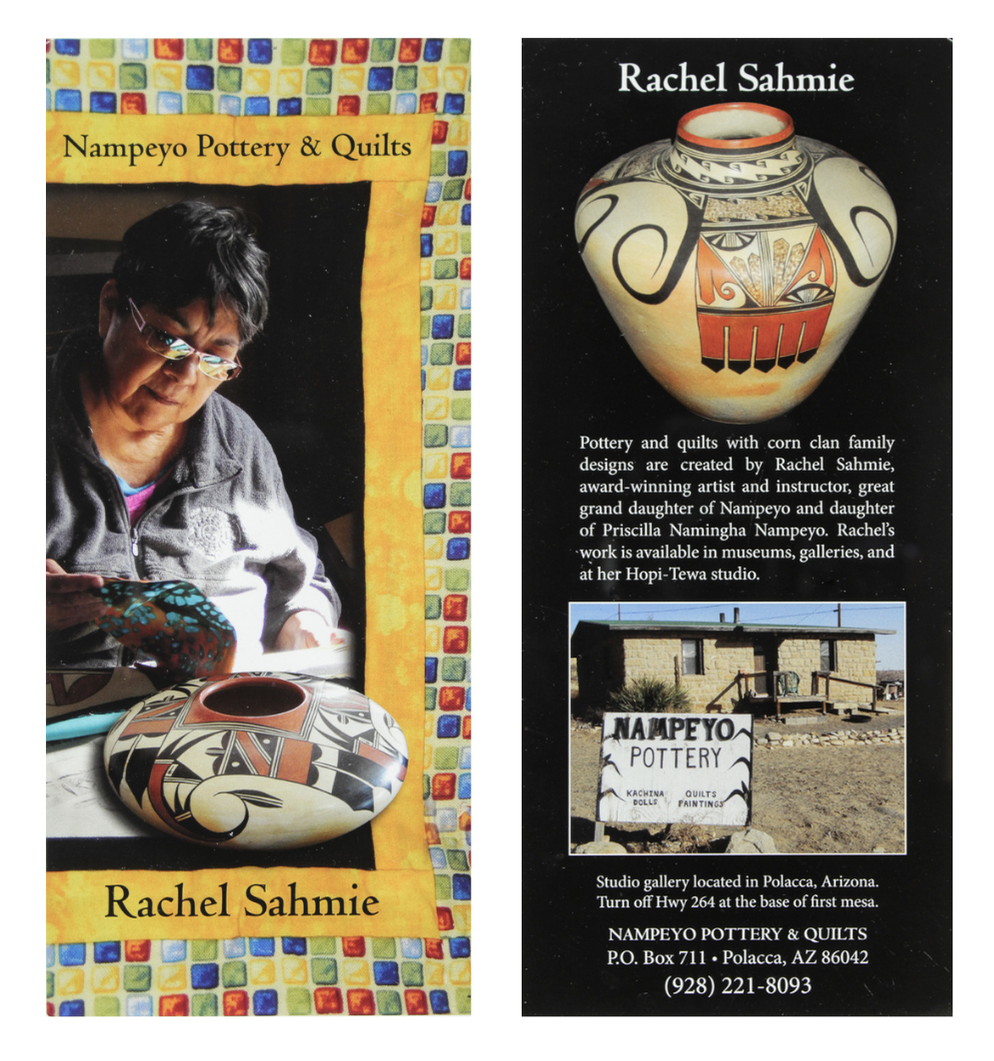
Pottery brochure for Rachel Sahmie, great granddaughter of Nampeyo and daughter of Nampeyo’s granddaughter Priscilla Namingha, sold from the home that Nampeyo built. Courtesy Rachel Sahmie.
Selling pottery has also enabled a form of cultural reproduction, permitting individuals and families to remain on the reservation to participate in kinship networks, ritual cycles, and the responsibilities and practices central to their cultural heritage. While they were innovators, both Nampeyo and Maria modernized cautiously in emphasizing the local values for pottery while drawing on other commercial practices they experienced. They no doubt struggled to maintain their community responsibilities in the face of the demands of pottery production. As the two artists matured, their novel actions became integrated into their roles as mature women. That they matured in their artistic production, increased their community status, and saw the economic impact of their work is a remarkable experience they shared in their lifetimes.
Authorship and Artistic Legacy
Each of these artists lived long and productive lives: Arroh-A-Och as a septuagenarian, Nampeyo, an octogenarian, and Maria, a nonagenarian. Each long life represented a significant accomplishment for the eras in which they lived and the profound changes they experienced at Laguna, Hopi, and San Ildefonso respectively. Maria left a written record through her biographers, with whom she collaborated. For Nampeyo and Arroh-A-Och, little of their articulations is available except as embodied by their pottery—or, in the case of Nampeyo, in the deep oral history of her family. For these two potters especially, their pottery is the medium in which they spoke most eloquently.
Beyond the Western canon of Native American art, their pioneering work is still remembered within their communities by the people whose lives they touched and continue to influence. In describing her revival of ancient Hopi pottery artistic styles, an early twentieth-century observation that Nampeyo was the founder of an “artistic school” proved prescient. Maria, too, proved to have an enormous influence as an artist and community leader. Arroh-A-Och posthumously brought fame to Laguna for its pottery while opening a door for alternative-gendered practitioners. These artists have thus enriched not only the world of art, but also the world at large, far beyond their notable lives.
The following pots were made by members of the Nampeyo family: Nampeyo, Priscilla Namingha Nampeyo, and Rachel Sahmie Nampeyo, respectively.
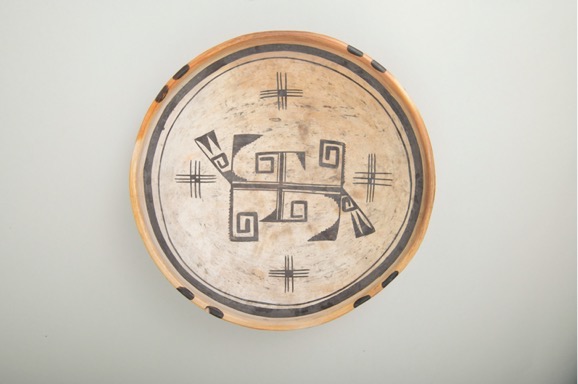
Black-on-yellow bowl by Nampeyo (?), c. 1900. Nampeyo adapted this design from designs on pottery excavated from the pre-contact site of Sikyatki. The style was labeled “Sikyatki Revival.” Maxwell Museum 72.11.4.
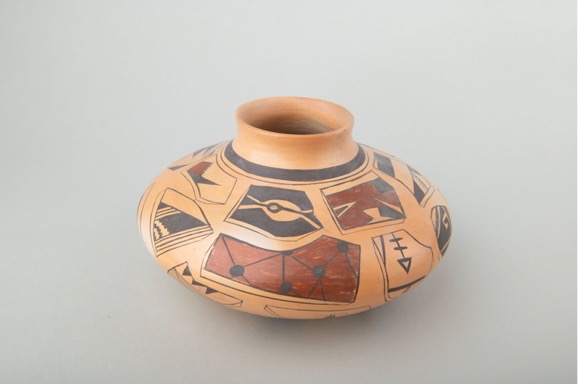
Polychrome jar by Priscilla Namingha, c. 1990. Priscilla was Nampeyo’s grand-daughter, the daughter of her first child, Annie. While Nampeyo often adapted Sikyatki revival designs and from whole vessels, Priscilla has painted this pot with designs from various Sikyatki (and older) pots sherds, representing the sherds in three dimensions. Maxwell Museum 96.34.14.
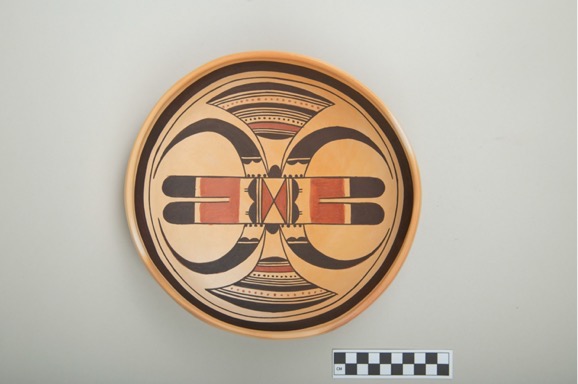
Rachel Sahmie polychrome bowl, 2020. Using Sikyatki-inspired designs and some of Nampeyo’s work, Priscilla’s daughter Rachel painted her bowl with unique designs that honor her family’s history working with this iconography. Note how well the design fits the shape of the bowl’s interior. Maxwell Museum 2020.12.2
The following pieces with feather designs were made by Maria Martinez in collaboration with her family members: husband Julian, daughter-in-law Santana, and son Popovi Da, respectively.
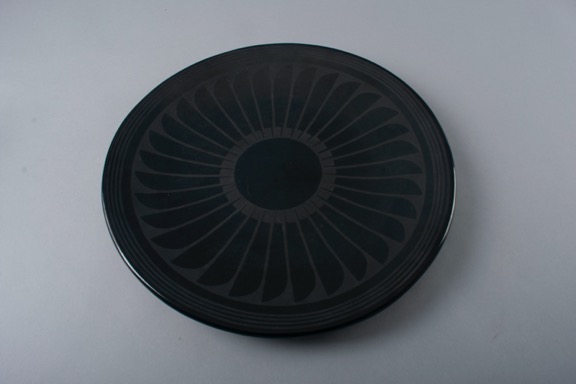
Black-on-black plate by Maria and Julian Martinez before 1943, when Julian died. Maria lived for nearly forty more years, passing away in her 90s.Maxwell Museum 2017.41.1

Maria Martinez and Santana Martinez Buff-on-red plate, c.1960. Maxwell Museum 67.74.37
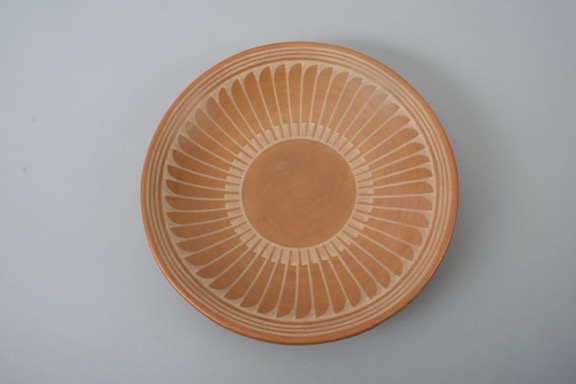
Maria Martinez and Popovi Da Cream-on-sienna plate, c. 1960. Maria and Julian’s son Popovi Da, sometimes known as Tony Martinez, like his father served as the governor of San Ildefonso Pueblo. Maxwell Museum 2020.10.1
Note: This essay is adapted from McChesney’s chapter, “Carrying On: Gender and Innovation in Historic Pueblo Pottery (Nampeyo, Maria Martinez, and Arroh-A-Och),” in Jill Ahlberg Yohe and Terri Greeves, eds., Hearts of Our People: Native Women Artists, pp. 86-95. Minneapolis and Seattle: Minneapolis Institute of Art and the University of Washington Press, 2019
Sources and Resources:
Jonathan Batkin, Pottery of the Pueblos of New Mexico: 1700–1940 (Colorado Springs, Colo.: Taylor Museum, 1987)
Mary Ellen Blair and Laurence Blair, The Legacy of a Master Potter: Nampeyo and Her Descendants (Tucson: Treasure Chest Books, 1999)
Ruth Leah Bunzel, The Pueblo Potter: A Study of Creative Imagination in Primitive Art (1929; repr., New York: Dover Books)
Karen K. Charley and Lea S. McChesney, “Form and Meaning in Indigenous Aesthetics: A Hopi Pottery Perspective,” American Indian Art Magazine 32, no. 4 (2007)
Dillingham, Rich, Acoma and Laguna Pottery (Santa Fe: School for Advanced Research Press,1992).
Florence H. Ellis, “Laguna Pueblo,” in Handbook of North American Indians, Southwest, ed. A. Ortiz (Washington, D.C.: Smithsonian Institution Press, 1979)
Walter Hough, “A Revival of the Ancient Hopi Pottery Art,” American Anthropologist, n.s. 19 (1917)
Gwyneira Isaac, “We’wha Goes to Washington,” in Reassembling the Collection: Ethnographic Museums and Indigenous Agency, eds. R. Harrison, S. Byrne, and A. Clarke (Santa Fe: School for Advanced Research Press, 2013)
Barbara Kramer, Nampeyo and Her Pottery (Albuquerque: University of New Mexico Press, 1996)
Dwight P. Lanmon, “Pueblo Man-Woman Potters and the Pottery Made by the Laguna Man-Woman, Arroh-A-Och,” American Indian Art Magazine 31, no. 1 (Winter 2005)
Alice Marriott, María: The Potter of San Ildefonso (Norman: University of Oklahoma Press, 1948; 14th printing, 1976)
Lea S. McChesney, “The Power of Pottery: Hopi Women Shaping the World,” Women’s Studies Quarterly special issue on Activisms 35, nos. 3–4 (2007)
“Carrying On: Gender and Innovation in Historic Pueblo Pottery (Nampeyo, Maria Martinez, and Arroh-A-Och),” in Jill Ahlberg Yohe and Terri Greeves, eds., Hearts of Our People: Native Women Artists, pp. 86-95. (Minneapolis and Seattle: Minneapolis Institute of Art and the University of Washington Press, 2019)
Ronald McCoy, “Nampeyo: Giving the Indian Artist a Name,” in Indian Lives: Essays on Nineteenth- And Twentieth-Century Native American Leaders, eds. Lester George Moses and Raymond Wilson (Albuquerque: University of New Mexico Press, 1985)
Tessie Naranjo, “Pottery Making in a Changing World: Santa Clara Pueblo,” Expedition 36, no. 1 (1994)
Elsie Clews Parsons, “The Zuñi La’mana” (1916), in Pueblo Mothers and Children, ed. B. Babcock (Santa Fe: Ancient City Press, 1991).
Susan Peterson, The Living Tradition of Maria (Tokyo: Kodansha International, 1977)
Will Roscoe, The Zuni Man-Woman (Albuquerque: University of New Mexico Press, 1991)
Richard L. Spivey, Maria, revised and expanded edition (Flagstaff: Northland Publishing [third printing, 1994], 1979)
Richard L. Spivey, The Legacy of Maria Poveka Martinez (Santa Fe: Museum of New Mexico Press, 2003)
Shelby J. Tisdale, “Maria Poveka Martinez: Her Life, Her Pottery, Her legacy at the Millicent Rogers Museum,” American Indian Art Magazine 31, no. 1 (Winter 2005)
For More information:
The Maria Martinez Family Pottery Collection:
https://millicentrogers.org/pages/maria-martinez-collection?_pos=1&_sid=87db10362&_ss=r
Nampeyo Showcase:
https://statemuseum.arizona.edu/online-exhibit/nampeyo-showcase
Arroh-A-Och’s pottery and contemporary Laguna potter Max Early:
https://www.fieldmuseum.org/blog/connecting-past-and-present-native-truths-our-voices-our-stories

